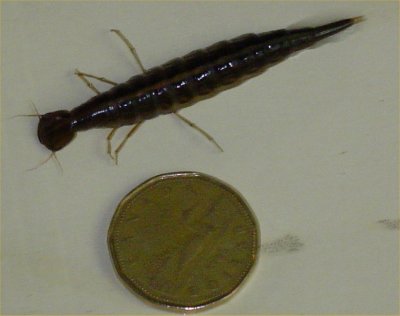 |
 |
|
|
Last Updated: 4/8/20
Beetle Introduction
Crawling Water Beetles
Waterlily Leaf Beetles
Predaceous Diving Beetles
Whirligig Beetles
Miscellenous Beetles
Coleoptera, or beetles, have a few species with aquatic larvae which are very predatory. Diving beetles and whirligigs are common adult beetles which stick around the pond. Because there are 280,000+ species of beetle, most people know what an adult beetle looks like. Few people, however, would identify dry-land worm-like creatures or what look like aquatic centipedes as beetle larvae. Most beetle larvae can be identified separately from other insects because their body is often covered in a much thicker, black plating and some species have long filaments off the sides of their bodies. One species of larvae looks like a caddisfly larvae with a suit of armor. Most range from 0.3 to 1 inch long but there are a large range of sizes. Likewise, their food preferences vary from plant to animal to detritus. Some kinds of water beetles follow.
Crawling water beetles crawl around eating plants as larvae but adults eat animals as well. Most of the 50 North American species range from 0.2 to 0.4 inches long. The larvae usually look like aquatic centipedes with very long filaments.
The waterlily leaf or Donacia beetles are predators of aquatic plants. Mostly they eat water lilies but may attack skunk cabbage, pickerel weed, and other plants. There are at least 36 species. They have a glossy body of black with green or yellow shiny specks. In the summer, adult females put o's in lily leaves and deposit their eggs through the hole under the waterlily leaf. Larvae make silk nests under the leaves. It takes about 10 months for an egg to result in an adult. Eggs and larvae can be wiped off leaves. If the infestation is bad, plants can be treated with insecticides outside of the pond and returned after a good rinsing. Remove dead vegetation around the pond to reduce the population of overwintering adults. Adults are a quarter to half an inch long.


Predaceous diving beetles can be found both as larvae and adults in ponds. Adults grow up to 1.5 inches depending on species while some larvae can grow up to 3 inches. There are at least 500 species in North America alone.
The larvae are called water tigers and have sharp pincers to eat tadpoles, their siblings, and other critters. Adults eat bugs, fish, tadpoles, each other, and frogs. They bring air bubbles underwater with them to breathe. In some species, oxygen from the water can diffuse into the bubble and extend the time a beetle can stay underwater. A chemical they produce is spread over the body to reduce water resistance (making it easier to swim), to repel predators (they taste bad), and to keep fungi and bacteria from attacking them. Adults spend a lot of time flying around and show up at night lights. During the winter, they stay in the pond. In China, some people eat them.
The diving beetle (Dytiscus) has two dagger-shaped mandibles that it impales into its prey. Through these, the beetles pump in toxins and enzymes that render the insides of the victim into liquid that the beetle can suck back up for food.
On 5/27/06, I noticed our pool cover was full of beetle larvae, maybe diving beetles. I am mentioning it because I noticed that some of the larvae would actually walk out of the water. I did not know they could do that. Whether that is normal, or they were doing it because of poor water quality, low oxygen, or lack of food sources, I do not know. Many were shriveled up around the edge of the cover though.
I found this beetle in my 30 gallon liner pond in 2012 and again in 2013 and then moved him to
the 153 gallon pond on 3/30/13 when I took this photo.
Adult predaceous diving beetle and a
ramshorn
snail waiting in a kiddie pool during the cleaning. This guy is probably Acilius
mediatus.
I found two in my 30 gallon liner pond on 3/30/20 when I cleaned it out as well.
Drawings of a larval and an adult predaceous diving beetle can be seen at this water bug site.
Whirligig beetles, Dineutus species, are some of the funniest insects to show up at
my ponds. The adults act like they have had too much too drink and spin around in the water.
The 0.5 to 1 inch adults are scavengers and can see above and below water at the same time.
Their front legs are long. Adults eat dead plants and animals and insects. The larvae, on the
other hand, eat whatever animals they can catch and have more noticeable filaments than legs.
Larvae are 0.8 to 1 inches long and crawl along the bottom. Larvae may eat insects, snails, and
mites.
Drawings of a larval and an adult whirligig beetle can be seen at this water bug
site.
Becky sent this link on 4/3/06:
Whiligig
Beetle - on the Australian Buglopedia site. Note that this is an archived version as the site
no longer exists.
A few other species with aquatic larvae are the water scavenger beetles (160 species, 0.3 to 1.5 inches long), dryopids (25 species, 0.5 inches), elmids (75 species, 0.3 inches), leaf beetles (0.1 inches), and tiger beetles (0.5 inches). Some eat animals, and some eat plants.
This aquatic beetle larvae of unknown species was stuck in the filter material from my 153
gallon
pond filter on 11/15/09. He was bent over backwards and biting at the filter material that was
holding his rear down.
Beetle larvae
1
|
|
Return to the main insect page.
See the master index for the insect pages.

|

|
E-mail RobynCopyright © 1997-2025 Robyn Rhudy |

|
 |